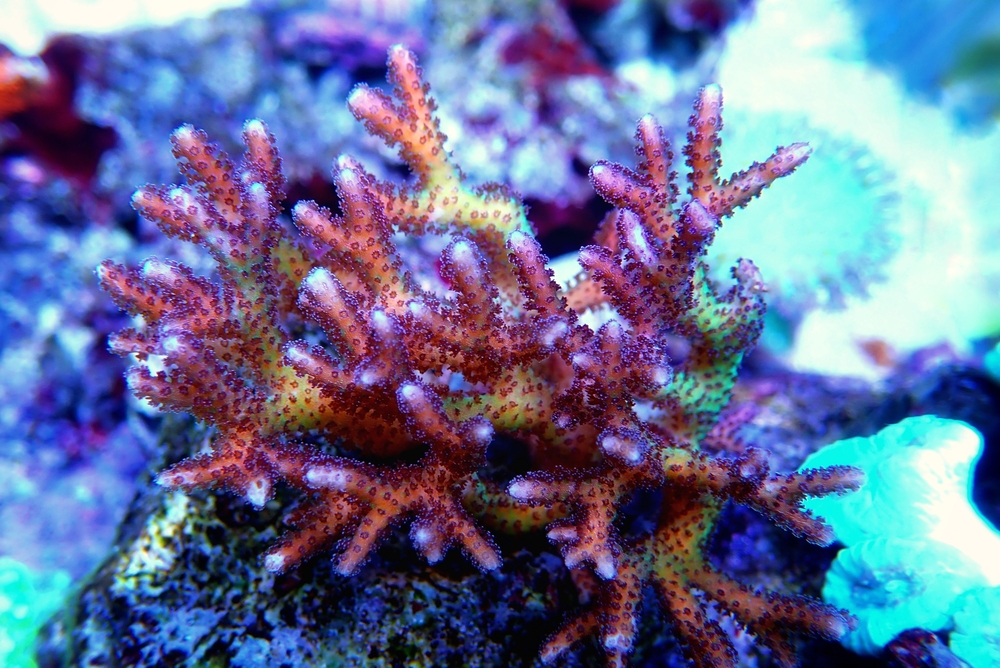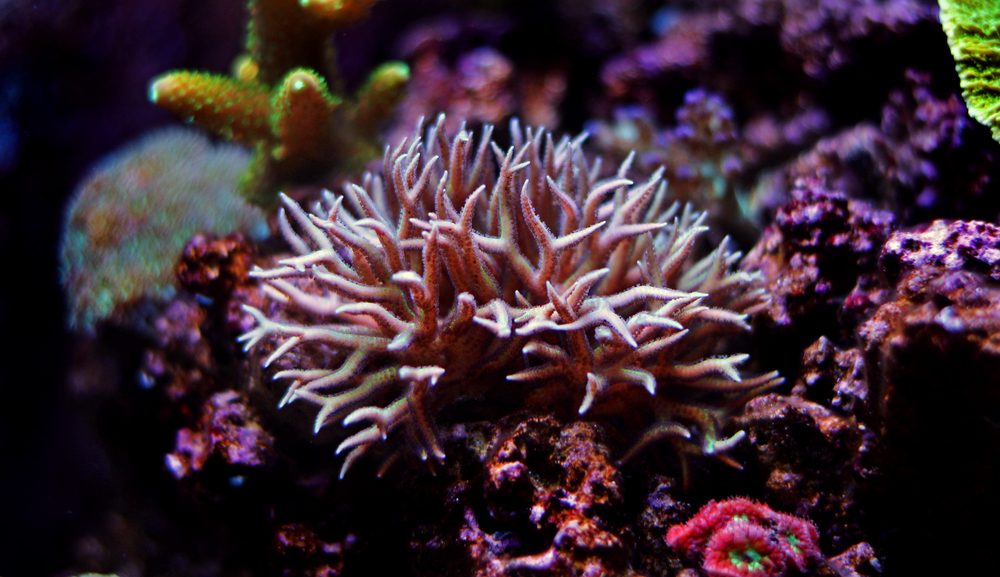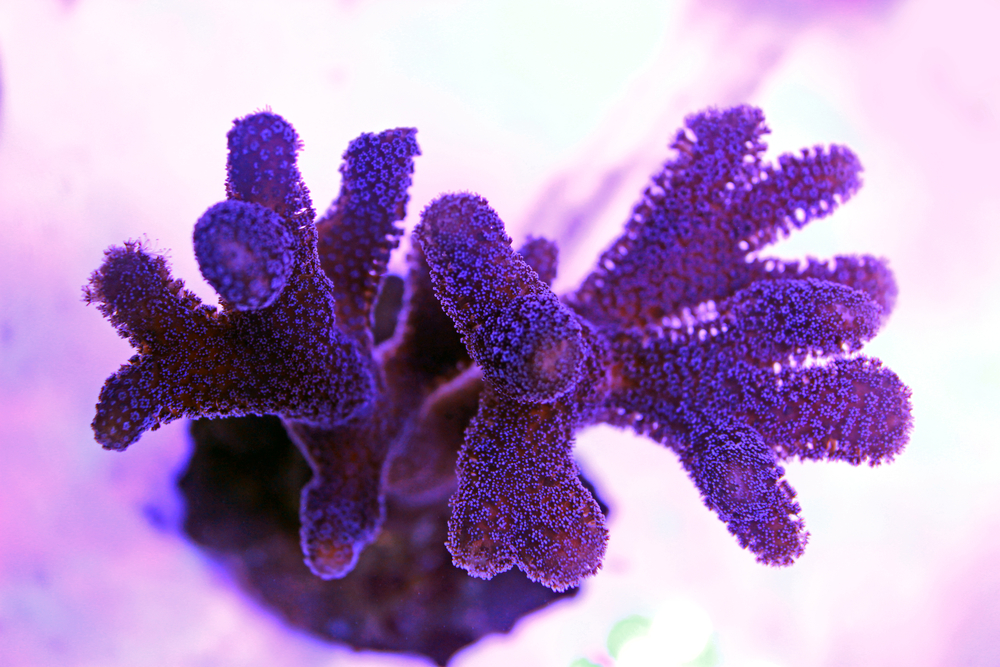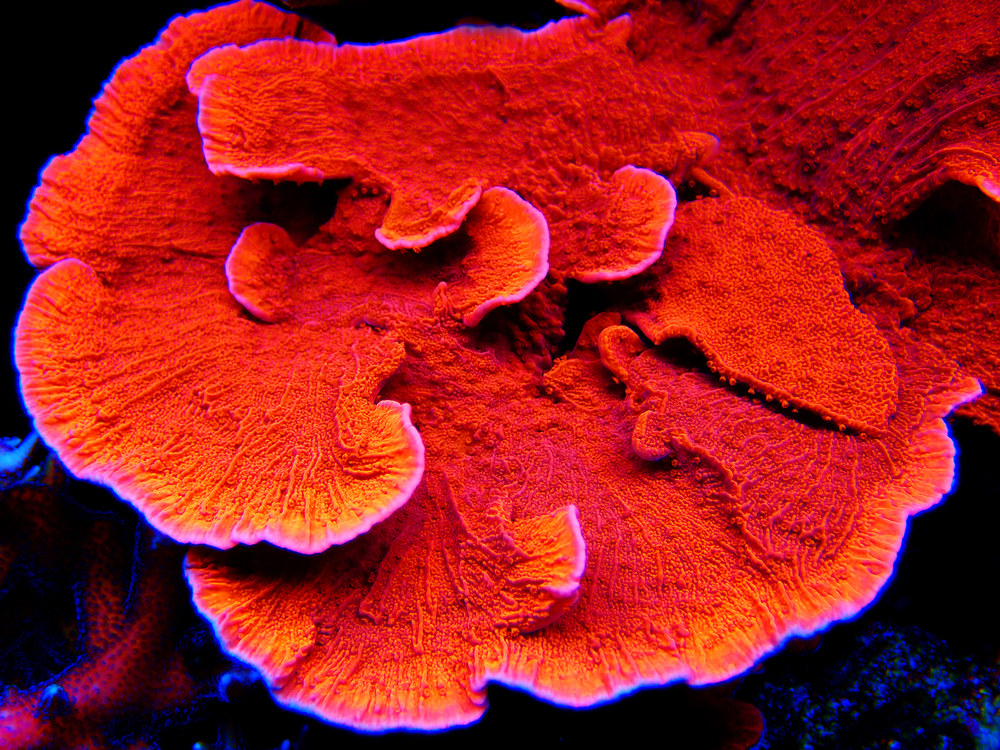SPS corals are, in many ways, the apex of the aquarium world in terms of care and beauty. There is so much that goes into keeping them healthy, from advanced chemistry to lighting and flow technology, that they may seem too scary for beginners to ever attempt. That said, there are a few really good species to cut your teeth on once you’ve grasped the basics to keeping SPS corals alive! Let’s talk a bit about just how to do so!
What are SPS Corals?
SPS (small polyp stony) corals are part of the building crew of the reef world. When you think of the fantastic branches and other shapes covered in living growth, you are imagining the works of SPS corals. There are also LPS (large polyp stony) and soft corals as well that each do their part to build a coral reef.
SPS corals are the most challenging types of coral to grow in a reef aquarium. They need intense lighting, continual, even water flow, and highly stable water conditions with exacting chemical parameters. Deviating even slightly from their requirements can cause a tank to crash as one coral’s death causes spikes in ammonia and other pollutants that kill the rest.
Corals are a primary example of mutually beneficial symbiosis in action. Each coral is actually a partnership as it contains within each cell single celled dinoflagellate algae. These algae gain shelter and a continuous flow of nutrients in exchange for sharing their sugar production with the coral.
Many SPS can therefore exist without actually needing to eat! They survive mostly on these algae-created sugars alongside organic trace molecules created through ocean chemistry and animal metabolic activity.
That said, most SPS corals still do eat because it fuels their growth rate. There’s no reason not to, not with a literal ocean of floating plankton waiting to be plucked out of suspension. Polyp size gives you a good notion as to what to feed your SPS corals; the smaller the polyps, the smaller the foods needed to keep them alive.
Even the easiest SPS corals are a challenge compared to other marine aquariums. But if you’re willing to learn, this guide is an excellent place to begin!

Caring for SPS Corals
All SPS corals, including SPS corals for beginners, need the following conditions to stay healthy and grow well:
Lots of Light
Of all the coral types, SPS corals are the most in need of intense lighting conditions. Many of them can live entirely on light and dissolved chemicals but without the light they will eventually die. You might be looking at anywhere from 100-300 PAR (photosynthetically active radiation) on the low end and bottom of the tank to as high as 600-700 PAR near the surface for others. The exact intensity depends entirely on the species and your aquarium depth.
With the warm temperatures and intense lighting of a reef aquarium, algae can be a tremendous issue. It can grow much faster than corals can and some types of macroalgae can overwhelm and smother corals with enough nutrients. Algae-eating fish like Lawnmower Blennies and members of your Saltwater Clean Up Crew, such as hermit crabs, are essential to keeping your corals spotless!
Algae is a major reason why paying close attention to nutrient levels is essential in the reef tank. Phosphate and Nitrate are major algae nutrients and need to be kept as low as possible.
That said, both Nitrate and Phosphate are actually used by many corals to feed their zooxanthellae so we don’t actually want 0ppm. But something in the range of 1-10ppm of Nitrate is ideal, with Phosphate near 0ppm, is best.
As for what type of lighting to use, your best options are modern LED fixtures, T5 fluorescents, and metal halide light sources. Metal halide lights were the first light source that was powerful enough in the right spectrum to open up reef aquariums for home hobbyists.
But they had a number of disadvantages as well. They emit dangerous levels of UV radiation as well, necessitating a filter to block it. They also get intensely hot and draw additional power from fans that keep them cool.
Many also don’t provide the full spectrum of lighting SPS corals need to fuel photosynthesis. But paired with the right spectrum of T5 fluorescent lights this isn’t an issue anymore.
On the other hand, they are a tried and true technology that SPS coral keepers have been using for decades. They also provide a stunning natural shimmer effect, simulating the sun over a tropical reef. Lastly, they often cost less compared to a full LED light fixture.
Modern LED lights are now extremely efficient and don’t get nearly as hot as metal halide lights. They can also be customized to match any spectrum required but they don’t offer as much shimmer as metal halides do. Lastly, a good LED grow light is typically more expensive than a metal halide source but costs continue to fall as demand rises.
Water Conditions
In order to maintain a constant, stable supply of essential elements, reef aquarists often rely on automated dosing regimens. This prevents a lapse in the schedule from causing sudden stress to corals. Likewise, adding large doses of a specific mineral or element once the corals have depleted it from the water can also be stressful.
The potential swings between abundance and lack are fundamentally different from the environment corals evolved in over hundreds of millions of years. In the ocean, water chemistry hardly changes over the course of even thousands of years.
Calcium reactors are a prime example. These devices contain crushed coral aragonite that has water saturated with carbon dioxide pumped into the main chamber. Carbon dioxide lowers the pH of water, allowing the aragonite to slowly dissolve. This calcium-rich water is then released back into the aquarium.
Many aquarists also use a Kalkwasser solution (a saturated solution of calcium hydroxide) instead or alongside a calcium reactor for faster growing species.
Since SPS corals are the most sensitive types of coral to work with, you’re best served by some level of automation. That said, if you want to try your hand at dosing properly without these devices, the following SPS corals are the ones you’re most likely to succeed with!
Other trace elements are also involved in intensifying the colors SPS corals display. Potassium is needed for blue pigments while Iron brings out the greens. Boron is important for red. Combined with high intensity actinic lighting (10,000K+ color temperature) your SPS corals will positively glow under the light.
The last main challenge is remembering that keeping elemental concentrations stable beats having to add them later because the lack of one creates a compound effect. Magnesium is what makes calcium bioavailable, for example. A lack of another element can cause cascading problems that mask the original cause. Remember, the most important thing for SPS coral is stability!
Water conditions for SPS Corals:
- pH: 8.1-8.4
- Temperature: 78-82℉
- Salinity: 1.023-1.026
- Nitrate: 1-10ppm
- Phosphate: <.03ppm
- Magnesium: 1200-1400ppm
- Calcium: 400-450ppm
- Strontium: 7-9ppm
- Iodine: .06ppm
- Boron: <10ppm
Feeding SPS Corals
Like nearly all coral and anemone species, SPS Corals are both photosynthetic and able to feed. The main difference is that SPS corals have tiny polyps and therefore can’t feed on larger prey items.
Instead of fish or shrimp they feed on zooplankton, copepods, cyclops, marine snow, and other tiny sources of organic matter. The size of the individual polyps is your clue as to what they should be fed.
All of the corals here will find marine snow substitutes to be an ideal food to fuel their growth. They can also survive solely on light but tend to grow much slower if not being fed. If your corals are meant to subsist entirely on light then you’ll need to place them in the tank accordingly. Light hungry corals should either be placed higher up near the light source or you should use more intense lighting for them
Feeding SPS corals also helps make up for the nutrients that may be lacking from their zooxanthellae. By depriving them of nitrate and phosphate, their internal colors brighten substantially because they have less brown zooxanthellae to darken their tones.
But less zooxanthellae means they are getting less food from their symbiotes, which we then need to make up for through feeding.
Another source of organic nutrients for SPS corals is their tank mates. Fish, invertebrates like shrimp, and other organisms create a steady flow of organic matter that SPS corals can directly feed on.
Reef safe fish are therefore an excellent addition to the SPS tank beyond just their beauty. But the key words here are “reef safe” because SPS coral are not tolerant of much nipping or grazing. Angelfish and Butterflyfish are some of the worst offenders in this regard, though many Pygmy Angelfish (Centropyge sp.) are reef safe if kept well fed on macroalgae.
Clownfish are excellent choices for the reef tank, as are small predators like Grammas, Basslets, Marine Bettas, and the like. Just be careful as these predators will consume small shrimp and other invertebrates you may like.
Tangs are also an excellent choice to keep alongside SPS corals as they are entirely herbivorous or planktivorous (Blue Hippo Tang), depending on the species.
The Seven Best SPS Corals for Beginners
SPS corals need not always be beyond your reach as a beginner reef keeper! Here are the seven best species to start out with!
Bird’s Nest Coral

Bird’s Nest Coral is an inexpensive, attractive SPS coral that’s typically green, pink, purple or yellow in color. Like all SPS coral, good water quality, flow, and lighting are essential to their care. Water flow also dictates whether the coral grows in an expansive or more compact form.
When establishing new frags of this coral, use a moderate flow for thin branches, increasing it as the coral starts to grow out. Watch out for the growing tips when doing maintenance as they are needle sharp and can easily pierce skin.
While they aren’t as aggressive as many LPS and soft corals, Bird’s Nest Coral can still be aggressive towards corals that are touching it directly. So give them a bit of space from their neighbors.
Bird’s Nest Coral also often has symbiotic crabs hosting it. These Coral Gall crabs encourage the coral to actually grow around it, forming a safe prison for it to snare nearby food with. Since they don’t do anything beyond local damage to the Bird’s Nest Coral, they aren’t an issue that needs removal.
- Common Names: Bird’s Nest Coral, Needle Coral, Thorns of Christ Coral
- Scientific Name: Seriatopora hystrix
- Origin: The Red Sea & East African Indian Ocean
- Temperament: Aggressive
Pink Stylophora Coral

Pink Stylophora is a cosmopolitan colonist and traveller. The coral larvae, the results of successful sexual reproduction, can adhere to floating debris like driftwood. This helps them spread far and wide, even beyond the reaches of their parent reef.
As befitting the diversity in habitats they can be found in, Cat’s Paw are some of the easiest SPS corals for beginners. They will even grow in less than ideal lighting and current situations, though not as well as in the conditions discussed earlier.
They are one of the hungrier SPS corals and should not be forced to live solely on their zooxanthellae. Cat’s Paw coral should be fed once per week on marine snow, zooplankton, or a similar source of food. You can also keep alongside fish and invertebrates, which will provide a steady source of organic matter for them to feed on.
This species has sweeper tentacles up to an inch in length. These tentacles are usually extended at night to snare nearby floating food and also attack neighboring corals. So give them space from their neighbors.
- Common Names: Cat’s Paw Coral, Smooth Cauliflower Coral
- Scientific Name: Stylophora pistillata
- Origin: IndoPacific Ocean
- Temperament: Semi-aggressive
Montipora sp.

Montipora corals are widely considered to be the best SPS corals for beginners. They come in a variety of appearances and colors but typically have an encrusting style of growth. Many of the plating species, such as Montipora capricornis and M. peltiformis also grow slightly upwards in the shape of thin coralline plates.
Montipora corals are, along with the Acropora genus, responsible for around a third of the mass of coral reefs on the planet! This makes them a highly sustainable coral species for harvesting from the wild. Collected frags also don’t harm the mother colony as Montipora are extremely hardy, both in captivity and in the wild.
Their appearance is often a clue as to their care requirements. Montipora corals with a smoother surface need less water flow while rougher textured species use their shape to channel the incoming flow.
These corals tend to be quite peaceful and need to be kept away from other species with sweeper tentacles and other mechanisms for aggression. Keep calcium levels on the higher end (450ppm) as MOntipora are active growers and quickly slow when levels drop off.
- Common Names: Plating Montipora, Plate Coral, Velvet Coral
- Scientific Name: Montipora Capricornis
- Origin: Mediterranean Sea, IndoPacific Ocean
- Temperament: Peaceful
Green Bali Slimer
The Bali Green Slimer is a legendary coral in the hobby that was one of the first SPS corals found that wasn’t nearly impossible to grow. Found in the central IndoPacific (especially around Indonesia), they are the fastest growing Acropora species in the world.
Bali Greens can double in size in the time it takes other Acropora to grow a few centimeters. They therefore tend to dominate reefs where they are found.
Green Bali Slimer gets its name from its defensive habit. If disturbed or damaged it exudes copious quantities of slime. This slime production is enough that you need to take it into account when fragging and moving this coral species. And their neon green color is beautiful to look at as well!
Combined with their general hardiness (for a coral) and quick growth rate, the Green Bali Slimer is an excellent SPS coral for beginners to start with. They prefer good current and strong lighting but will adapt to moderate levels of both. Green Slimers are also quite peaceful towards neighboring species of coral.
- Common Names: Green Bali Slimer Coral
- Scientific Name: Acropora yongei
- Origin: Central IndoPacific (Bali, Indonesia)
- Temperament: Peaceful
Leaf Coral
Leaf Coral (and their cousins in the genus Pavona) are some of the most disease resistant corals in the hobby. They have deeply embedded corallites that give extra protection to their corallites from opportunistic parasitic infections.
Leaf Coral also does extremely well without feeding so long as light levels are high. They have a remarkable ability to convert carbon dioxide and other inorganic nutrients directly into usable organic molecules. And they also feed on dissolved trace organic molecules. Just the leavings of your fish, shrimp, and other corals are usually enough for Leaf Coral to grow well!
In moderate light conditions Leaf Coral does better with supplemental feedings to make up for the lack of light, however. Keep in mind that they are a highly aggressive species with stinging sweeper tentacles that can reach up to 6 inches past their surface. So place them with both lighting and temperament in mind.
- Common Names: Leaf Coral, Cactus Coral
- Scientific Name: Pavona decussata
- Origin: IndoPacific
- Temperament: Aggressive
Boulder Coral
Boulder Corals are a fascinating species that deserve a place in every beginner’s SPS aquarium. For starters they are some of the longest lived organisms on the planet! Boulder Coral colonies can reach over a thousand years in age and grow nearly 30 feet in height!
Fortunately, it takes them a long time to get big because they are also some of the slowest growing corals around. They typically grow a centimeter per year or less, ensuring that it will be a long time before your Boulder Coral outgrows its enclosure.
Like all SPS corals they prefer high lighting and ample water flow to get the nutrition and light they crave. Strong flow is important for waste removal and food access; these corals grow in some of the most turbulent portions of the reef.
While they are quite submissive and easily damaged by aggressive neighbors, Boulder Coral is also very good at recovering from attacks. Even if portions of the skeleton that are entirely killed off the coral will eventually recalcify. Given the highly competitive environment of a coral reef it makes sense to have a robust regenerative ability in exchange for rapid growth.
Their other common name, Christmas Tree Coral, refers to the fact that they are the favored host of Christmas Tree worms, a species of small Feather Duster. The worms aren’t harmful to the coral colony and add a delightful flair with their fan-like filter feeding appendages.
Boulder Coral can subsist entirely on light and dissolved nutrients. But the worms do require occasion feedings of phytoplankton or zooplankton, which the coral can also consume.
- Common Names: Boulder Coral, Christmas Tree Worm Coral
- Scientific Name: Porites sp.
- Origin: Worldwide
- Temperament: Peaceful
Maldivensis Coral
Maldive Corals have several attractive features that make them great SPS corals for beginners. They are some of the least food dependent corals in the hobby as they can metabolize dissolved organic matter and carbon dioxide directly into food molecules.
Combined with adequate lighting they can live entirely without actual food. Like most corals that live off of dissolved light and organics they need a nice, turbulent flow to ensure they have a steady stream of food. These qualities mean they are always found in less than 80 feet of water in nature as the shallows provide the current and lighting they crave.
If your lighting is less than ideal, you can still make up for it by feeding them on marine snow or zooplankton sources. They can form both encrusting or massive growths over a meter across but they typically grow less than a foot in diameter.
Like all Pavona sp. (such as their relative the Leaf Coral), the Maldive Coral is a highly aggressive species. It has sweeper tentacles that will extend at night as much as six inches beyond itself to sting its neighbors.
And since this happens at night many beginner SPS coral keepers are baffled to find their coral mysteriously dying while the Maldive Coral innocently sits at a distance. This aggressive distant warfare necessitates a ton of space so they don’t kill nearby corals.
- Common Names: Maldive Coral
- Scientific Name: Pavona maldivensis
- Origin: IndoPacific Ocean
- Temperament: Aggressive

